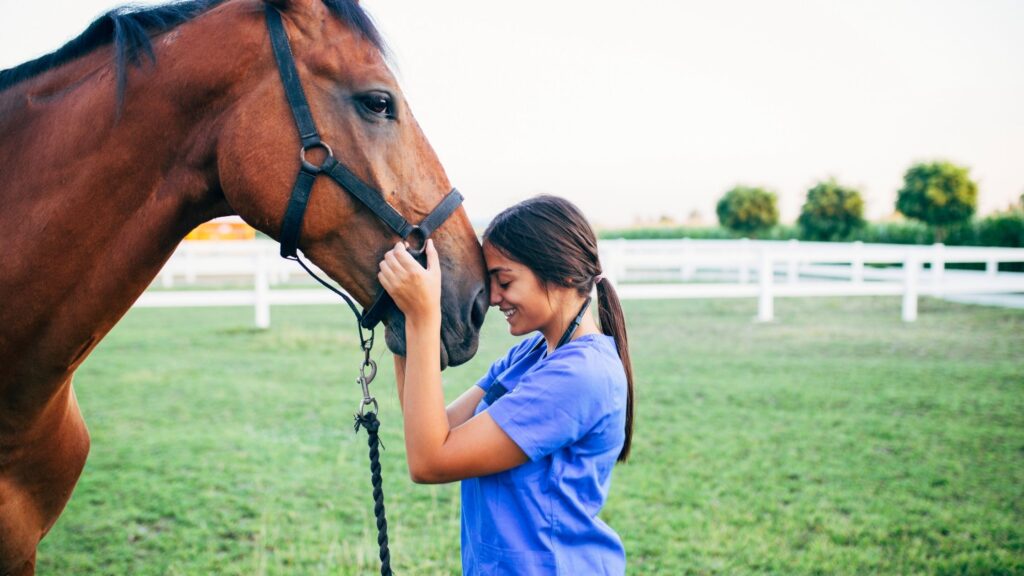Table of Contents
ToggleIntroduction

In recent years, the therapeutic benefits of interacting with animals have gained widespread recognition, leading to the emergence of various animal-assisted therapy programs. Among these, Miniature Horses Therapy has emerged as a unique and effective approach to improving the well-being of individuals facing physical, emotional, or cognitive challenges. These pint-sized equines, with their gentle demeanor and affectionate nature, offer a novel avenue for therapeutic intervention that goes beyond traditional methods.
Origins Of Miniature Horses Therapy
Historical Context and Roots in Equine-Assisted Therapy
The roots of Miniature Horses Therapy can be traced back to the broader field of equine-assisted therapy, which has a rich historical context. Human-animal interactions, particularly with horses, have been recognized for centuries for their potential therapeutic benefits. The origins lie in the understanding that the bond formed between humans and horses extends beyond practical purposes, such as transportation or labor, and can have profound effects on emotional well-being.
Ancient cultures, including the Greeks and Romans, acknowledged the healing properties of horse-human connections. The therapeutic potential of equine-assisted activities gained momentum in the 20th century, with the development of structured programs aimed at leveraging the unique qualities of horses to address various psychological and physical issues.
Evolution of Using Miniature Horses Specifically
While equine-assisted therapy flourished, the idea of using miniature horses specifically for therapeutic purposes emerged as a distinct and innovative approach. The evolution of this concept can be attributed to the realization that the smaller stature of these horses makes them more accessible and less intimidating for individuals of all ages and abilities.
Miniature horses, standing at no more than 34 inches in height, share the same gentle nature and intuitive qualities as their larger counterparts. Their diminutive size, however, allows for increased mobility and ease of interaction, making them suitable for diverse therapeutic applications. The evolution of using miniature horses in therapy marked a shift toward inclusivity, enabling a broader range of individuals, including those with physical limitations or children, to benefit from equine-assisted interventions.
Training And Selection Of Therapy Horses
Criteria for Selecting Suitable Miniature Horses
The process of selecting miniature horses for therapy involves careful consideration of various criteria to ensure their suitability for interacting with individuals in therapeutic settings. Key factors in the selection process include temperament, health, and compatibility with the intended therapeutic goals.
Temperament: One of the foremost criteria is the horse’s temperament. Therapy horses must possess a calm and gentle demeanor, exhibiting patience and tolerance in various situations. A non-reactive and predictable temperament is essential to create a safe and positive environment for interaction.
Health and Wellness: The overall health of the miniature horse is paramount. Regular veterinary check-ups, vaccinations, and proper nutrition are crucial to maintaining the well-being of therapy horses. Good health ensures that they can effectively engage in therapeutic activities without compromising their own welfare.
Compatibility: The selected miniature horses should be compatible with the target population and the specific therapeutic goals. Consideration is given to factors such as age, size, and physical condition to ensure that the horses can comfortably and safely interact with individuals of different ages and abilities.
Specialized Training Programs for Therapy Horses
Therapy horses undergo specialized training programs designed to equip them with the skills and behaviors necessary for successful engagement in therapeutic activities. These training programs focus on acclimating the horses to various environments, stimuli, and human interactions.
Desensitization: Miniature therapy horses are exposed to a variety of stimuli to desensitize them to potentially distracting or frightening elements. This includes getting them accustomed to wheelchairs, medical equipment, and various sounds to ensure they remain calm and composed during therapy sessions.
Obedience and Commands: Training includes teaching horses basic obedience and responding to specific commands. This enables handlers to maintain control over the horse and ensures a predictable and safe interaction with participants.
Boundary Awareness: Therapy horses are trained to maintain appropriate boundaries with individuals, respecting personal space. This skill is crucial in ensuring that the therapeutic interaction is comfortable and non-intrusive for participants.
Applications Of Miniature Horse Therapy
Healthcare Settings (Hospitals, Rehabilitation Centers)
Miniature horse therapy has found a significant role in various healthcare settings, providing a unique and valuable therapeutic experience for patients in hospitals and rehabilitation centers. The presence of these gentle equines has been shown to have positive effects on individuals recovering from surgeries.
Physical Rehabilitation: In rehabilitation centers, therapy horses can be incorporated into physical therapy sessions to enhance motor skills, balance, and coordination. The gentle and rhythmic movements of the horse can simulate the natural gait of walking, offering a dynamic and engaging form of physical exercise.
Emotional Support: Miniature horses provide emotional support to patients coping with the challenges of illness or recovery. The non-judgmental and affectionate nature of these animals creates a soothing environment that complements traditional medical interventions.
Educational Environments (Schools, Special Education Programs)
Miniature horse therapy has gained popularity in educational settings, particularly in schools and special education programs, as an innovative approach to enhancing learning experiences for students of all ages.
Emotional and Social Development: Interaction with therapy horses promotes emotional and social development in students. The presence of these animals fosters a sense of responsibility, empathy, and connection, benefiting the overall emotional well-being of students.
Special Education: In special education programs, therapy horses can play a crucial role in addressing the unique needs of students with diverse abilities. The calming effect of the horses and the tactile experience of interacting with them can support sensory integration and improve focus.
Conclusion
Miniature Horses Therapy stands as a testament to the remarkable impact that the animal-human connection can have on our well-being. The journey through this exploration has illuminated the origins, applications, and numerous benefits associated with this innovative form of therapy. As we witness the profound effects of these pint-sized equines on individuals facing various challenges, it becomes evident that Miniature horse therapy transcends conventional therapeutic approaches.







